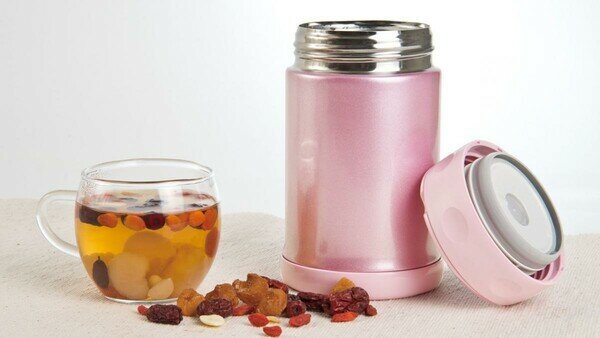Vacuum insulated food jar is popular in recent years, and claimed that it can be used for cooking. Recipes can also be found in the market to teach the busy consumers to use it for fast cooking.
The Consumer Council alerts consumers that vacuum insulated food jar has no heating function, and therefore should not be used for cooking raw meat. Furthermore, the food stewing inside the jar should be consumed within 6 hours to minimise food safety risk.
Some recipes have instructions to stew semi-cooked meat and seafood with a vacuum insulated food jar. However, consumers should beware that the jar does not come with a heating function so cooking raw meat would risk undercooking. Consumers might get sick after consumed these meats. Ingredients like shellfishes, mushrooms and eggs should also be fully cooked before stewing in a vacuum insulated food jar.
Vacuum insulated food jar is designed for stewing function. The vacuum space between the double layers of the container provides heat insulation. This enables food to be held at or above 60̊C for 4 to 6 hours and keep cooked food soft, tender and tasty. A proper use of the jar can simplify food processing steps and save energy, fitting the needs of singles and small-size families.
There are 2 tips for proper usage of vacuum insulated food jar: dice ingredients into small pieces and cook to boiling or well-done. The jar should be pre-heated with boiling water for about 5 minutes, before putting the heated cooked ingredients into the jar for further stewing. For easily cooked foods such as spaghetti, congee and instant noodles, even without pre-cooking, they can still be fully cooked with boiling water inside the pre-heated jar.
Consumers should also avoid keeping food with high salt content in a vacuum insulated food jar because stainless steel is susceptible to rust in a salty environment, resulting in degradation in durability. If the food is high in salt content, consumers should eat them as soon as possible and clean the jar thoroughly. Besides, consumers should avoid putting large amount of water-swelling food like kelp and laver into the jar as increase in their sizes will block the valve on the lid and make it difficult to open.
To ensure its efficacy, consumers can test the vacuum insulated food jar themselves. First, pre-heat a small amount of white rice in boiling water and put them into the pre-heated jar, then close lid tightly. After 4 to 6 hours, if the rice are cooked and soft, and the water temperature is still maintained at 60̊C or above, this means that the efficacy of heat insulation is satisfactory. However, if the surface of the jar is scalding to hand, there may be problems with the heat insulation.
The design of vacuum insulated food jar is very similar to thermal mug. The most notable difference is the bigger opening of vacuum insulated food jar. Another major difference is the coating of inner wall. Many thermal mugs have a glare-proof coating; the insulated jar has not such a coating since the coating may be damaged when users scoop food out of the container with a spoon.
Here are some tips for consumers when choosing vacuum insulated food jars:
- Pick the appropriate volumes according to the amount of food you need to cook. Soup should be held with a container of 750ml or above. A lunch box for one person or food for toddlers and young children should be held with a container of 500ml and 350ml respectively;
- The efficacy of heat insulation of a vacuum insulated food jar should be able to hold the food at 60̊C for a minimum of 4 to 6 hours to prevent food from spoiling;
- Choose vacuum insulated food jars with valve on the lid since it is more convenient to open;
- Clean the food jar soon after use. The lid set should be dissembled and cleaned with warm water and detergent. Use the cleansing powder specially designed for food jar if there is stubborn stain. For cleaning red rust, soak it for 30 to 60 minutes with 10% of white vinegar diluted with hot water.
The Consumer Council reserves all its right (including copyright) in respect of CHOICE magazine and Online CHOICE (https://echoice.consumer.org.hk/).



